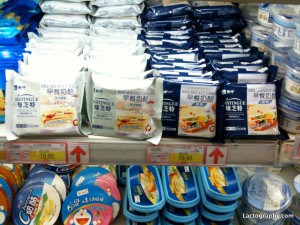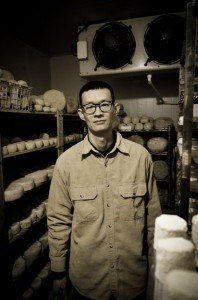
In this blog series, Molly will be (virtually) traveling around the globe to explore the way cheeses are enjoyed and incorporated into different cuisines. Some of these cheeses and methods might seem familiar, while others might be completely new to you. Last week, we talked about India and the county’s recognizable paneer cheese. This week we learn about China and one lucky reader will win a free copy of culture! Get more stamps on your cheese passport and join us for a historical and cultural adventure!
While many countries on this journey are known for and even defined by the aspects of their culture related to cheese, I thought it was important to stop in China, a place with very little in the way of cheese culture. In my research, I was surprised to discover that Chinese cheese does exist, and I found some interesting reasoning about why the Chinese palate isn’t as receptive to cheese as other foods.
Traditionally, dairy products were associated with nomads who lived on the borders of China and were considered fearful barbarians. Crowded conditions in many parts of the vast country also made it impractical to keep and raise the pastured animals required for cheesemaking. Most Han Chinese, the dominant ethnic group, are lactose-intolerant, and therefore avoid dairy. Soybean and tofu provided similar nutrients as dairy in their diets. Due to western influences, some Chinese parents have begun feeding their children milk, and the country does import some foreign-made industrial cheese. For most parts of the country, this food group is absent from most people’s diets, though the market for it has been growing steadily over the past few years. All of these reasons help to explain the fact that the food culture of the country simply does not support the inclusion of cheese in the same way other countries do.

Packages of cheese in a grocery store in China | Photo Credit: Image courtesy of Lactography
Fuchsia Dunlop, an author who writes about her experiences with Chinese culture and food, helps to shed some light on the lack of cheese in the country. In this article for the Financial Times, she tells the story of bringing a variety of cheeses for a tasting at the famous Xianheng Tavern in Shaoxing. Many of the chefs in attendance had never tasted cheese before. Dunlop reflects on the experience in her blog:
It was fascinating to be able to witness some very accomplished Chinese chefs tasting cheese for the first time in their lives, and gave me a new perspective on one of my favourite types of food.
Chinese cuisine does include many types of similarly stinky foods, such as fermented bean curd skins, translated as “fermented thousand layers” and semi-rotted vegetables. Dunlop assumed the jump to rotted milk should not be too hard to accept, but most tasters agreed that while stinky vegetable foods might make your breath smell bad, they clear out of your mouth quickly after eating, while a smelly Brie de Meaux coats your mouth and the animal-like flavor lingers much longer. They also did not like the slight bitter aftertaste of the Stichelton (the unpasteurized version of Stilton) they tried.
Foreign-style cheesemaking is present in some places, such as Le Fromager de Pekin in Beijing. Owner and cheesemaker Liu Yang studied management in France, where he tasted cheese for the first time, and immediately fell in love. Once returning home, he started making cheese in his own kitchen, which eventually led to the Beijing Gray, China’s first camembert-style cheese. Now he creates 13 different types of cheeses, all made with cow’s milk, and his customer base – mostly foreigners living in Beijing – is slowly expanding to local Chinese.

Cheesemaker Liu Yang in his shop | Photo Credit: Image courtesy of The Savoury Road
You have to travel to the southern part of the country to find Chinese-style cheese. In the Yunnan province, ethnic minorities like the Sani, Bai, and Naxi have historically been involved in dairying. Rubing is a specialty of the cuisine of the area, a goat’s milk cheese that is often compared to paneer or halloumi because it doesn’t melt. Traditionally it is pan-fried or steamed, and it can be sweetened or salted for serving. Rushan is another style of cheese produced in that region, thin air-dried strips made from cow’s milk that are twisted around a dot of sweet red bean, then deep fried. With globalization and the continuing exchange of cultures, hopefully the traditional cheeses of China will become more available for those of us who can’t take the trip over there.
Have you ever had the chance to sample any Chinese-style cheese? Tell us about it in the comments below for a chance to win a copy of our summer issue! Comments must be posted by 11:59 p.m. EDT on Tuesday, August 12, 2014, to be eligible to win. So comment today and stay tuned for next week’s post!
Photo Credit: Featured image of cheese tasting courtesy of China Economic Review




https://www.facebook.com/media/set/?set=a.554225581322752.1073741851.449711491774162&type=3
Thanks for the pictures!
Nest stop – South Korea? The farmers there are starting to make cheese for local sale – supported by Dr. Bae of Sunchon University and the college’s Pilot Plant for teaching cheesemaking!!!
How interesting! I will have to look that up.
No, how interesting!
Thanks for reading and commenting!
I have never sampled Chinese cheese …this article was fascinating!
I’m glad you enjoyed reading it!